by Bernhard Bockelbrink | Apr 22, 2024 | blog
Over the years, we incrementally refined how the practical guide presents organizational development and organizational structure.
After much deliberation in the last year or two – relating to helping organizations work with the Common Sense Framework, and to studying how successful organizations set constraints on organizational structure, we discovered that we could provide people with a more helpful and more practical approach for evolving organizations, which we now laid out in the Practical Guide. We added several new patterns, retired a few others, and made quite substantial changes to some of the existing patterns. We also sketched a new section of the guide that discusses organizational structure, which we are going to flesh out later
separating patterns for evolving structure from specific examples of larger structures, integrating more broadly with other existing frameworks and approaches that develop organizational structures, so that S3 remains
Purpose of Domains
In the context of a domain, we now refer to the combination of the primary driver and the corresponding requirement as the purpose of a domain, and we updated the Delegation Canvas and S3 Organization Canvas accordingly.
We also updated our recommendation for what to include in a domain description. We extended the description of Clarify and Develop Domains to include a detailed description and examples for each aspect of a domain description, and we also added an example domain description (in the appendix). Clarify and Develop Domains now contains more information about how and when to clarify domains, and how domains are developed. These changes will soon be reflected in other patterns related to metrics and evaluation.
With this change came two new entries to the glossary: Standard Constraint, Overall Domain
Patterns Relating to Organizational Development
Before the recent change, S3 was leaning on patterns that show concrete structures of different levels of complexity:
- basic building blocks on the level of individuals and teams (e.g. role, circle, link)
- structures that connect those teams (eg. delegation circle)
- and complex structures for entire organizations and beyond (Peach Organization, Service Organization)
In addition to that S3 contained a few meta-patterns that informed the development of structure, like Clarify and Develop Domains, Align Flow, and Create a Pull-System for Organizational Change.
Since we first described these patterns about organizational structure, we found that many organizations use the building blocks, and the structures that directly build on those, but the more complex patterns are used less often, and tend to be adapted more. Also we encountered organizations that had entirely different ideas about larger structures that were rather clever, but also very specific.
We did not want to add tens of new structures to the practical guide, because that would be – for lack of a better word – rather impractical. Therefore we started looking for what these larger structures have in common, and what sets them apart. In the end, we arrived at a collection of patterns that do not describe structure, but define enabling constraints for structure, so that a complex network structure can emerge.
These are the new patterns:
- Enable Autonomy and Collaborate on Dependencies explain how to strike the balance between autonomy and collaboration (both were already integrated as principles in the Common Sense Framework)
- Manage the Whole System supports people in bringing together the individual strands of organizations, departments or projects
- Design Adaptable Systems is focused on how to “design” organizations that can grow but still respond to change by developing a set of constraints for structure and growth
- Financial Transparency supports people make better decisions, and it builds trust and accountability – which in turn enables more autonomy and better collaboration
- Share Costs and Gains is a very common pattern, but it has also interesting applications larger structures that incentivize innovation and entrepreneurship
- Invest in Ongoing Learning is a bit of an outlier, because it has a slightly different focus, however it will eventually explain how to create structures for learning
With these changes, we decided to moved Delegate Circle and Service Circle into Building Organizations, and we removed Delegate Influence, because the value it provided is now described in the new pattern Enable Autonomy, and in the upcoming changes to Contract for Successful Collaboration.
For now, the new patterns we added only contain a brief summary. We chose to Deliver Value Incrementally, and roll out the new structure of the practical guide before completing all the contents. That being said, we have a full backlog of upcoming changes, and lots of notes and drafts in various stages of completion, so eventually, all new patterns will have a complete and useful description.
Dedicated Chapter about Organizational Structure
A few of the new patterns mentioned above might strike some people as a rather odd take on organizational structure, therefore we created a dedicated chapter about organizational structure, where we will add general observations, case studies, examples, and a discussion of how S3 patterns relate to how organizational structure is presented in several existing frameworks for organizational structure. This chapter is also the new home for Peach Organization, Service Organization, Fractal Organization, and Double-Linked Hierarchy, which we now present as examples of complex organizational structure.
by Bernhard Bockelbrink | Apr 22, 2024 | blog
In 2024 we made two significant updates to the Practical Guide: we introduced Requirement as a core concept distinct from the Driver, and we revised how organizational development – especially organizational structure – is presented in the guide. Those changes distill the essence of years of supporting organizations in applying S3 patterns and principles, and from watching organizations meet challenges and leverage opportunities. In this post, I’ll briefly sum up what has changed around Drivers and Requirements, and point you to the relevant bits in the guide. I’ll follow up with another post about Organizational Structure soon.
Requirements
We found that distinguishing between a driver (a situation that is relevant for the organization to respond to) and the associated requirement (the need considered necessary to fulfill to respond to a driver adequately) makes it easier for people to get clear about the situation first, and then make a decision about the scope and direction of an adequate response, before getting into the details. (See Drivers and Requirements for a more detailed description of drivers and requirements).
Since Drivers are a core concept in S3, separating the Requirement from the Driver was not done by simply adding an explanation of Requirements to the core concepts (see Drivers and Requirements), we also revised several patterns and glossary entries throughout the guide, and updated the recommended patterns in the Common Sense Framework. Here’s a list of the most significant changes:
New Pattern
We added the new pattern Determine Requirements that describes how to figure out and agree on an appropriate requirement.
Revised Patterns
(in alphabetical order)
Changes to the Glossary
Of course we added a new entry in the glossary for Requirement, and we revised several existing entries, either to refer to a Requirement, or with a description that no longer contains a reference to the Driver.
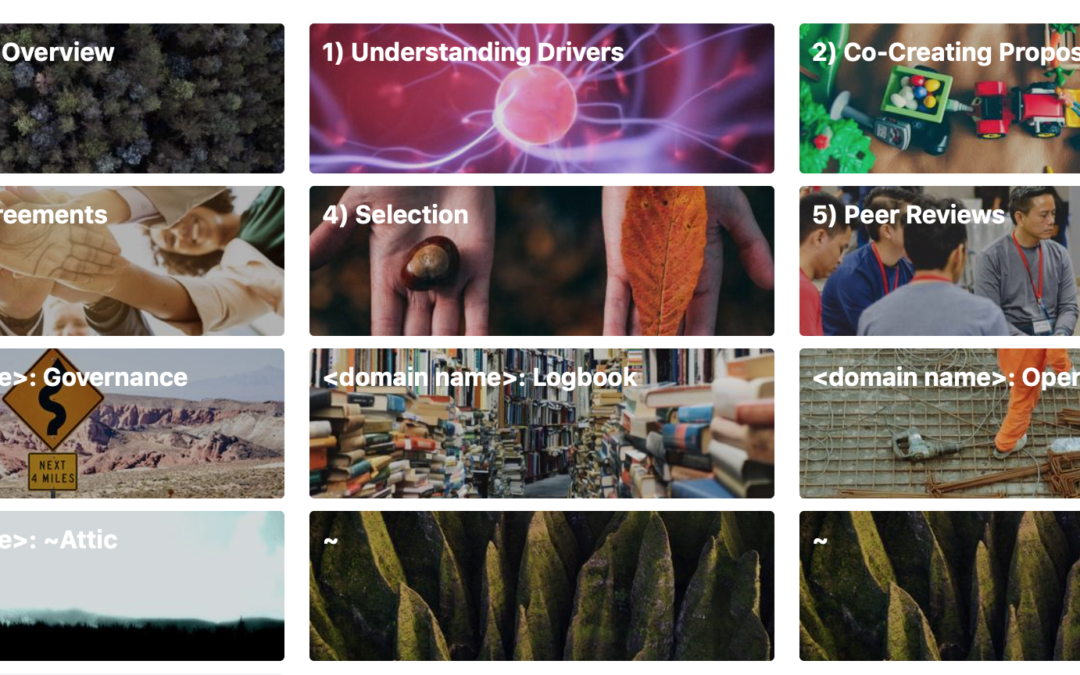
by Bernhard Bockelbrink | Mar 26, 2020 | blog
A couple of years ago I created some resources for online collaboration that might be of relevance these days:
Both go well with my free practical guide for virtual meetings (German only for now).
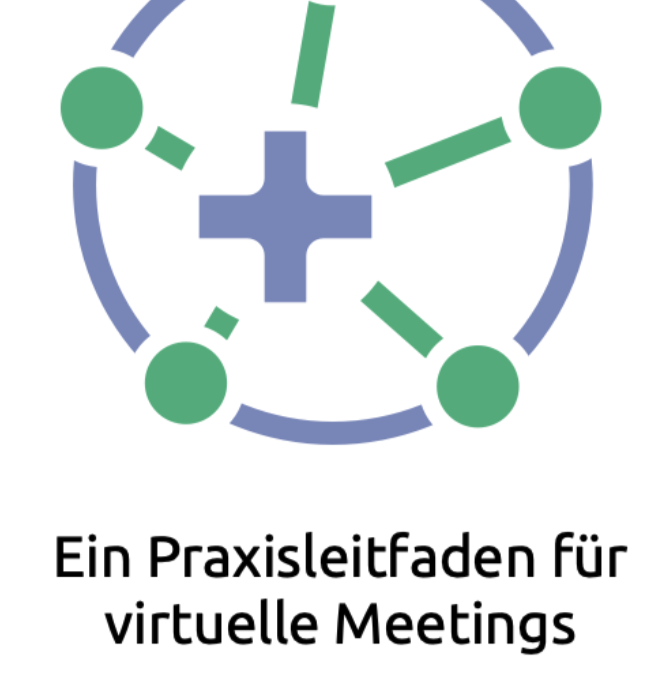
by Bernhard Bockelbrink | Mar 24, 2020 | blog
Nachdem sich nun plötzlich sehr viele von uns in der Situation befinden, wahrscheinlich für die nächsten Monate von zu Hause aus arbeiten zu müssen, habe ich einen Leitfaden für virtuelle Meetings verfasst, um kleinen einen Beitrag dazu leisten, diese Arbeit so stressfrei und so produktiv wie möglich zu gestalten.
Und wenn wir es schaffen, in der aktuellen Ausnahmesituation die Fähigkeit aufzubauen, ähnlich effektive und produktiv zusammenzuarbeiten wie wenn wir uns alle im selben Raum befinden, wird es uns dadurch nicht nur gelingen, unsere wirtschaftliche Existenz zu sichern, sondern wir könnten vielleicht sogar auch später auf viele Autofahrten, Flüge und Reisezeiten verzichten, und dadurch mehr Freizeit haben und die Umwelt schonen.
Der Leitfaden steht unter einer Creative Commons Lizenz.

by Bernhard Bockelbrink | Apr 18, 2019 | blog
Ein “Dojo” ist ein Raum, in dem man gemeinsam lernt, übt und praktiziert. Ein #s3dojo öffnet den Raum, um Soziokratie 3.0 zu erleben, zu erlernen und zu vertiefen. Es ermöglicht praktisches, erlebnisorientiertes Lernen sowie die Anwendung des Gelernten, dabei werden — soweit möglich und gewünscht — konkrete Probleme und Themen der Teilnehmer behandelt, so dass mit echtem inhaltlichen Engagement gearbeitet und relevante Ergebnisse mitgenommen werden können.
Das #s3dojo selbst folgt agilen und soziokratischen Prinzipien, das laufende Dojo wird immer wieder auf den Bedarf der Teilnehmer angepasst, so dass jede Gruppe ihren eigenen Weg zu S3 entdecken und beschreiten kann.
Dazu stehen vorbereitete Materialen, Module und Aktivitäten zu Einführung und Vertiefung verschiedenster Themen bereit, aus denen die Teilnehmer, nach Bedarf auswählen können, oft werden aber auch die in der Einführung erlernten Gestaltungs- und Entscheidungsmuster dazu verwendet, bestehende Module auf die aktuelle Situation der Gruppe anzupassen oder gemeinsam neue Aktivitäten zu entwickeln.
In einem #s3dojo übernehmen alle Teilnehmer gemeinsame die Verantwortung für Ablauf und erfolgreiche Umsetzung des Dojos. Auf dieser Basis begegnen sich alle Teilnehmer — auch Moderator(en) und Trainer — von Anfang an auf Augenhöhe, und stehen als Gruppe miteinander in einer Beziehung, die die Grundlage für eine soziokratische und agile Arbeitsweise innerhalb des Dojos bildet. Dies ermöglicht, viele Muster und Formate aus S3 als Gruppe auf das Dojo selbst anzuwenden, und insbesondere auch kunstvolle Teilnahme zu erleben und einzuüben.
Jeder Tag des Dojos beginnt mit der Gestaltung des gemeinsamen Rahmens und der Agenda, unter tags gibt es immer wieder Standortbestimmung und Gelegenheiten, Erlebnisse zu teilen und Antworten zu finden, und am Ende des Tages findet eine Reflektion des Erlebten und der eigenen Erwartungen, sowie eine Evaluation des Gesamtbildes statt.
Zur Anmeldung
Weitere Informationen zu #s3dojos gibt es auf s3dojo.de
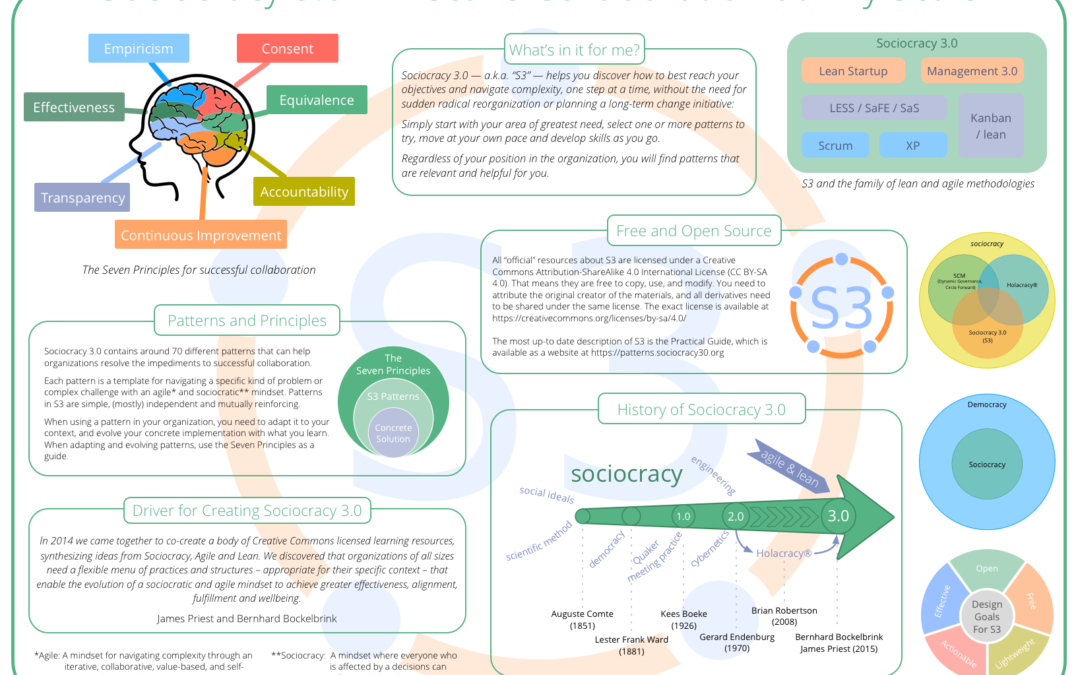
by Bernhard Bockelbrink | Nov 14, 2018 | download, s3dojo, Sociocracy 3.0, workshops/trainings
Here’s the second part of the posters I use in my S3 dojos to give people an overview over S3, the lens we view organizations through, and how people can use 70 patterns to respond to various challenges and opportunities in their organizations.
You can download the full set combined into one pdf that can be printed A1 or even A0. All the patterns in the pdf are clickable, so you can jump directly to the explanation of a pattern on the patterns website. The posters relate to the latest, as of now unreleased version of the practical guide, so some of the links (to new and renamed patterns) will only work after the next release.
Download Posters
Below you will find a brief description of each of the seven posters:
Sociocracy 3.0 – Effective Collaboration at any Scale
This poster introduces S3 and puts it into the context of various agile frameworks and methodologies.
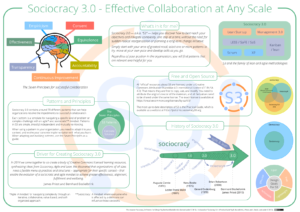
Making Sense of Organizations
This poster explains the relationships between drivers, domains, strategy and experiments, and how organizations identify and respond to drivers.

Responding to Complex Challenges
All the patterns related to making and evolving decisions and agreements in complex situations.
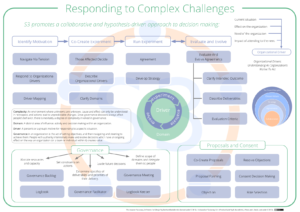
Building Structures for Collaboration
Those patterns hat are helpful for defining domains and for evolving organizational structure in support of effective agile collaboration.
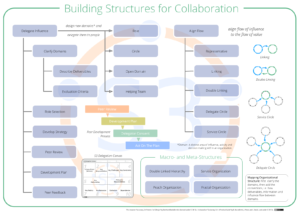
Operations – Organizing and Doing the Work
Patterns for self-organization, work process and effective meetings.

Enabling Engagement
While all patterns in S3 promote an agile and sociocratic mindset, the patterns in this poster are especially helpful in promoting a cultural shift in the organization.

Pattern Map
A (clickable) map of all patterns in S3.
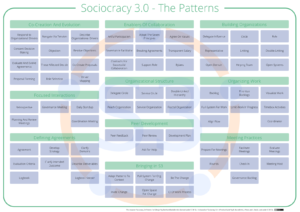
Download Posters

by Bernhard Bockelbrink | Nov 14, 2018 | download, s3dojo, Sociocracy 3.0
I have developed a set of posters for my S3 dojos, which I will make available under a Creative Commons license. The posters work well when printed in A1, for larger groups A0 might be a better choice.
The first poster I want to share is a poster about the Cynefin framework, which is very helpful at the beginning of a dojo to introduce participations to the concept of complexity, and to explain why they are typically using the wrong toolkit in their organizations when addressing the problems they are facing.
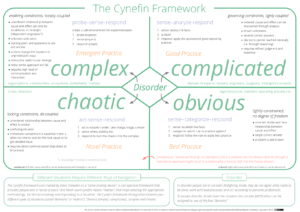
Download Cynefin poster (PDF)
Also there is a poster (in German) with all the patterns of the latest (so far unreleased) set of S3 patterns:

Download German Pattern Map poster (PDF)
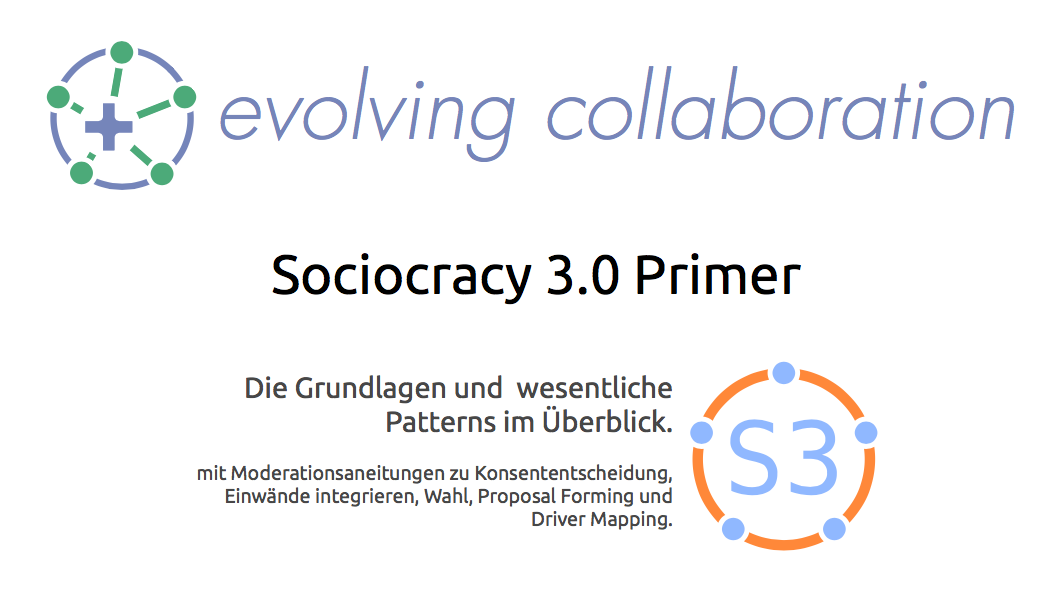
by Bernhard Bockelbrink | Jun 2, 2017 | blog, download, news
Im Rahmen meiner S3 Trainings und Workshops habe ich einen “Sociocracy 3.0 Primer” entwickelt, der die Grundlagen zusammenfasst und detaillierte Moderationsanleitungen zu allen wesentlichen Formaten (z.B. Konsententscheidung, Einwände integrieren, Wahl, Proposal Forming und Driver Mapping) enthält. Der Primer bezieht sich auf die momentan aktuelle Version von S3 und wird ständig weiterentwickelt. Er steht unter <https://evolvingcollaboration.com/s3-primer> zum Download zur Verfügung (vorerst nur auf in deutscher Sprache).
Wie alle Materialien zu S3 steht auch der S3 Primer unter einer Creative Commons Free Culture License.
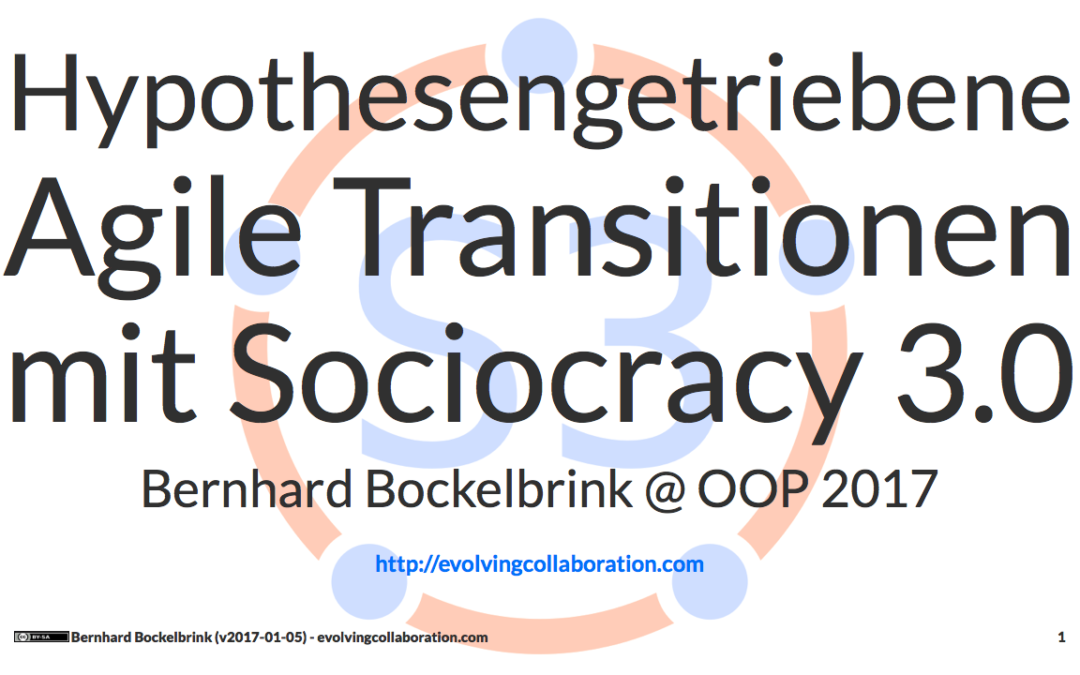
by Bernhard Bockelbrink | Feb 10, 2017 | blog, slide deck, workshops/trainings
Die Transition einer kompletten Organisation wirft viele Fragen auf: Was ist agile Buchhaltung, agile HR, oder agiles Management? Gibt es eine Blaupause für agile Organisationen, oder muss man das alles irgendwie selbst heraus finden? Und wie begegnet man dem existenziellen Risiko, das jede große Veränderung birgt?
Der Vortrag zeigt, wie man diese komplexen Fragen mit hypothesengetriebenen Methoden und Ideen aus Sociocracy 3.0 agil und iterativ angehen kann, um den Weg zu einer lernenden Organisation zu finden, und was man dabei beachten sollte.
Folien zum Vortrag: Download als PDF | Ansehen auf Slideshare
Details
Jede Organisation muss ihren eigenen Weg zur Agilität finden, für viele auf dem Weg auftretende Fragen gibt es keine allgemein gültige Antwort, dazu sind Organisationen einfach zu unterschiedlich.
Als Organisation muss man mit dieser Unsicherheit leben lernen, das bedeutet aber nicht, dass man das Problem nicht strukturiert angehen kann. Inzwischen kennt man hypothesengetriebene Ansätze z.B. zur Entwicklung von Business-Modellen, Produkten oder im Marketing, das Prinzip lässt sich genauso auf agile Transitionen anwenden.
Der erste Teil beginnt mit einem kurzen Überblick über Agilität und Komplexität, und eine kurze Begriffsbestimmung der Soziokratie/Sociocracy 3.0/Holacracy, und erklärt dann das Prinzip hypothesengetriebener Methoden auf Grundlage von Sociocracy 3.0, und deren Applikation auf agile Unternehmensentwicklung: Mitarbeiter per Konsententscheid in die Gestaltung der sie selbst betreffenden Experimente involvieren, und den Rahmen dafür schaffen.
Im zweiten Teil geht es um die Implikationen für die Unternehmenskultur allgemein, und wie man speziell die Herausforderungen Zielorientierung, HR, Hierarchie/disziplinarische Führung angehen kann.
Der dritte Teil beschäftigt sich mit praktischen Fragen: konkrete Strategien zur Transition, die Balance zwischen Autonomie in der Wertschöpfung und Alignment, lernenden Organisationen, Organisationsstruktur vs. Software-Architektur (Conway’s Law), Softwareunterstüzung der Transition, und dem Umgang mit agilen Frameworks, die nicht evolutionär, sondern revolutionär eingeführt werden wollen.
Viele der in diesem Vortrag vorgestellten Ideen sind Patterns aus Sociocracy 3.0, einem offenes und freien Framework zur Entwicklung agiler Organisationen, das, ähnlich der Holakratie, aus der Verbindung agiler Methoden mit der Soziokratischen Kreismethode (SKM) entstanden ist.
Wie alle von mir erstellten Materialien zu Sociocracy 3.0 stehen auch die Vortragsfolien unter einer Creative Commons Free Culture Lizenz.

by Bernhard Bockelbrink | Jan 30, 2017 | blog, download, news, slide deck, Sociocracy 3.0
James Priest, Lili Davidis and I spent a lot of time on a complete overhaul of the “All Patterns Explained” slide deck:
- patterns are grouped in a more meaningful way
- some new patterns and more descriptive names for existing patterns
- lots of updates, corrections, clarifications in the pattern descriptions
I also created some new illustrations for the slide deck, and updated a lot of existing ones. An update to the image repository will follow.
Download the slide deck as pdf, or as an archive with all slides as png.
Here’s an updated map of all the patterns and the categories: 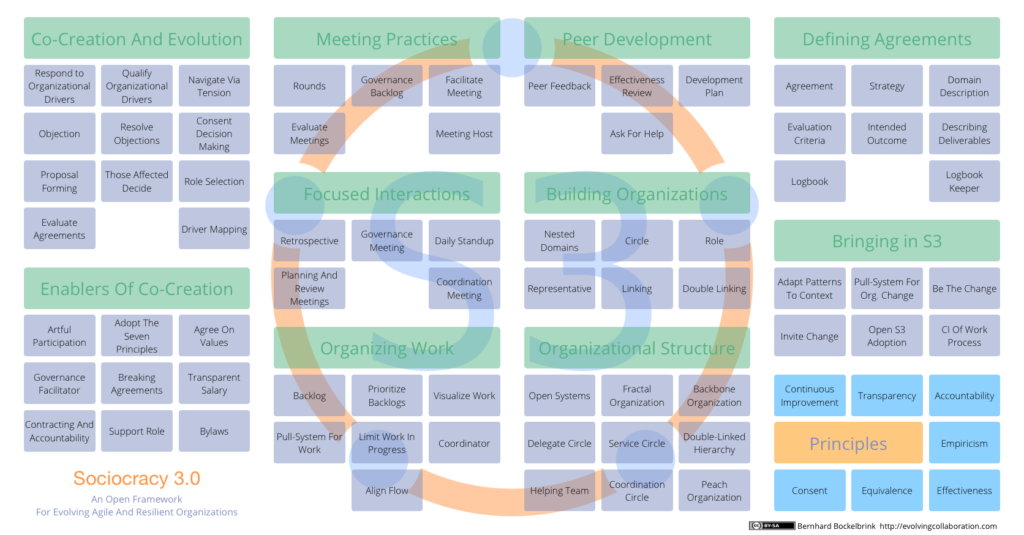
Enjoy!


















